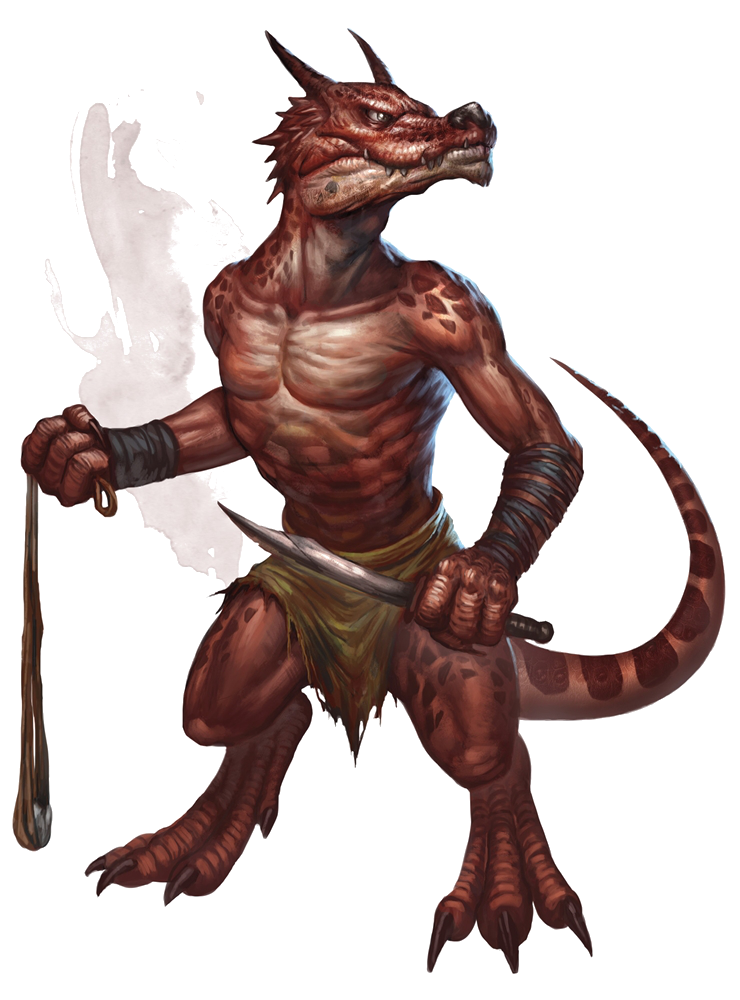Kobold
A kobold was the youngest form of a dragon. Freshly hatched from the egg and abandoned by their parents, kobolds were left to fend for themselves, often accruing a reputation for childlike mischief and troublemaking. They resembled small, flightless dragons, with features and coloration to match their draconic parents.
As a kobold aged, they slowly matured into a dragonborn.
Appearance
Kobolds were much shorter than most humanoids, standing between 3 and 4 feet tall, though they grew quickly and would soon tower over much humanoids as dragonborn. Soon after hatching a kobold's scales were a dull brown color but as they aged, their scales adopted the same color as their parent dragon. Most kobolds sported horns or ridges or spines to match their dominant parent dragon though dimorphism was common, leading to some unusual color and horn combinations. Once laid, kobold eggs took about a year to hatch. Upon hatching kobolds were fully autonomous and intelligent, though they typically lacked practical experience about the world. Apart from this early spike, they matured at roughly the same rate as other humanoids and weren't considered full dragonborn until approximately twenty years old. However, considering the world's many dangers, most kobolds did not survive to adulthood and especially not to dracomorphosis. Out of each clutch of eggs, one kobold was born a kasdah, blessed with leathery wings and an understanding of Draconic. A kashak typically led a kobold gang but was often the most likely to survive to complete dracomorphosis.Culture
Lifecyle
A pregnant dragon would lay a clutch of roughly one hundred eggs somewhere remote, safe from predators. The dragon would then abandon the eggs and return to her lair, often lying in torpor for approximately a century, in order to give the newly-hatched dragons a chance to establish a foothold. Most dragons were completely unsentimental about their own young and often saw immature dragons of their brood as competition. After a year of incubation, the dragon eggs would hatch into one hundred kobolds. These kobolds – often led by their kashak – would immediately form a strange, juvenile society. These childish gangs, removed from outside society, could be immensely cruel and barbaric, as the unsupervised kobolds struggled to survive in the remote wilderness surrounding their nests. They often constructed crude lairs, outfitted with booby traps and ruled by the strong, in the manner of unruly children. As they matured into dragonborn, more and more kobolds would leave the gang to seek civilization in the wider world. Those kobolds were the ones most likely to eventually transforms into full-blown dragons.Hoards
Like their draconic parents, kobolds were often driven to hoard items, particularly treasure. Many of them did not entirely understand the reasons for this – it was simply a compulsion they could not ignore. It was also common for kobolds to hoard items that would not help them dracomorphosize, typically due to their low value. Kobold hoards of buttons, doorknobs, books or even pets have been discovered. This tendency proceeded into their adulthood but would often sharpen, their childhood obsessions melting away in favor of more treasure.Kobold Ancestral Traits
- Ability Score Increase: Your Dexterity score increases by 2 and your Charisma score increases by 1.
- Size: Your size is Small.
- Speed: Your base walking speed is 30 feet.
- Grovel, Cower & Beg: As an action on your turn, you can cower pathetically to distract nearby foes. Until the end of your next turn, your allies gain advantage on attack rolls against enemies within 10 feet of you that can see you. Once you use this trait, you can’t use it again until you finish a short or long rest.
- Pack Tactics: You have advantage on an attack roll against a creature if at least one of your allies is within 5 feet of the creature and the ally isn’t incapacitated.
- Draconic Ancestry: You have draconic ancestry. Your damage resistance are determined by the dragon type, as shown in the table. You have resistance to the damage type associated with your draconic ancestry.
- Languages: You can speak, read, and write Common and Draconic.
Kobold Heroes
Remove these ads. Join the Worldbuilders Guild





Comments